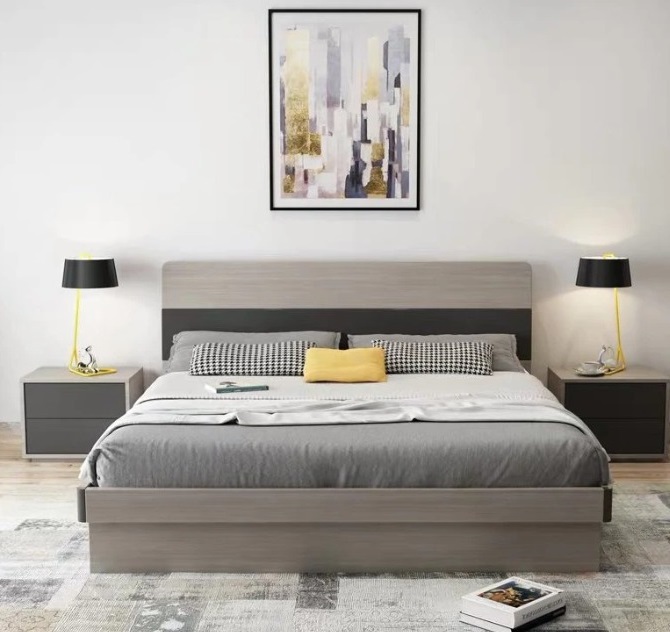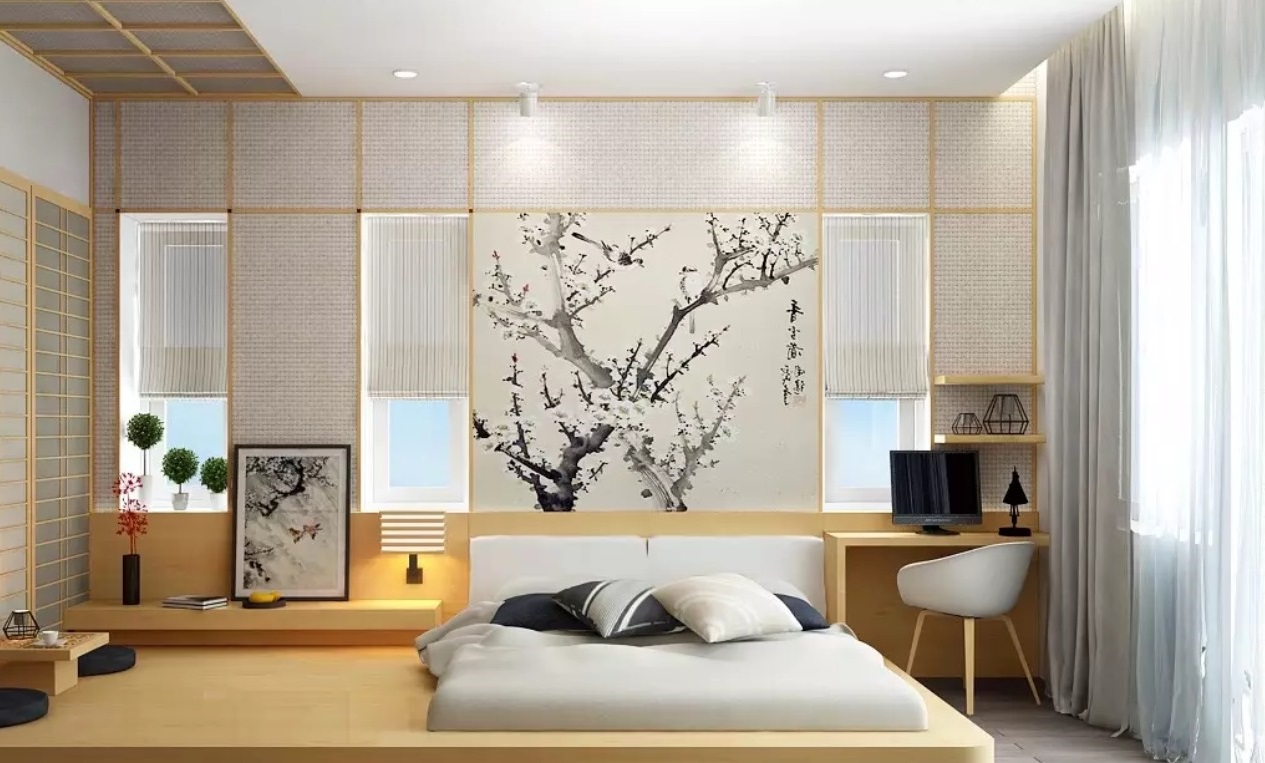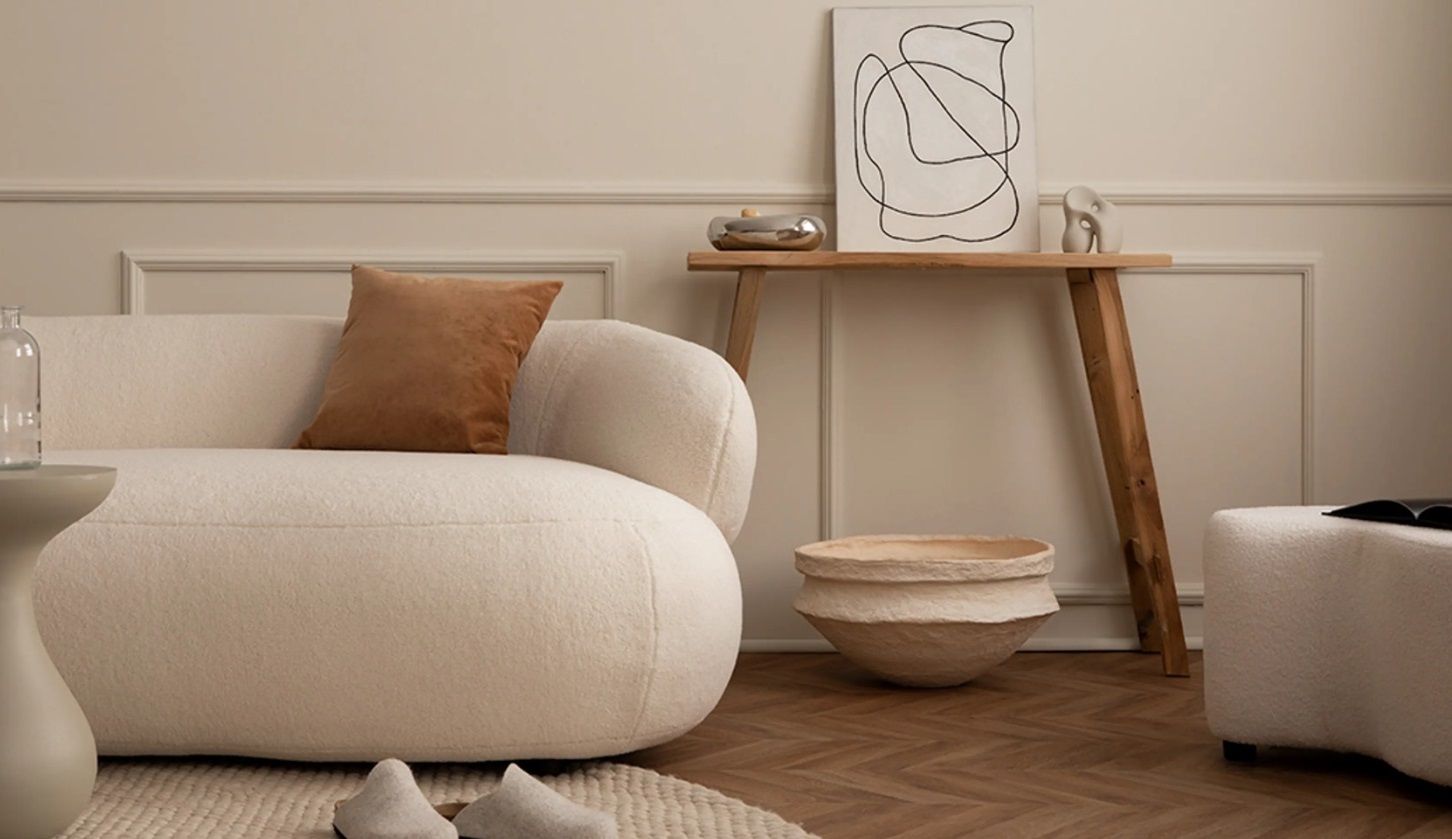The scaled down look is cool and neutral? Absolutely not! It’s just a matter of displaying some special pieces properly
A minimalist interior has many advantages, for example making it easier to clean. But most importantly, it’s about consciously saying yes to the things around you every day. That’s why the house doesn’t have to seem cold and sterile! We will tell you how you can give your apartment a minimalist look without having to sacrifice style and individuality.

Avoid cabinet handles
Cabinet doors with tip-on fittings or hidden handles in place of traditional handles are a great way to start. To make a wall unit more individual, make a statement or two, like here with oversized white handles.
To do this, simply unscrew the old handle and carefully fill the resulting hole with a suitable filling compound – which is why we recommend coating it now with a new coat of paint. You can also use this opportunity to repaint your cupboards. Push-to-open devices or tip-on fittings can be purchased at hardware stores and are very easy to install. And for statement handles, feel free to look around other departments – even a simple coat hanger like “The Dot” from Muuto can be repurposed wonderfully.
Limit yourself to a few items on open shelves
Open shelves will look better if they are not cluttered. Just choose your favorite works and arrange them according to your wishes. Think of open shelves as your personal gallery. And if you get bored, you can always reset it.

Make a statement with modern art
A large format piece of art will look neater and create a beautiful backdrop for your furniture. Colorful and abstract artwork in particular can add something definite to a minimalist room.
Add accents with color
With a minimalist look you don’t have to give up color completely. If you’re not sure, choose neutrals for larger areas and some bright colors for furniture, home accessories, or art.
It doesn’t always have to be a white cube
A minimalist interior doesn’t mean everything has to always be white. For example, play with certain materials that you use thoroughly. In this bathroom, mosaic tiles have been added to almost all the surfaces. Although the structure varies, the overall design of the room remains beautiful and simple.
Use curtains properly
Curtains that cover the entire height and width of the wall provide an elegant atmosphere to any room. Choose simple fabrics and make sure the curtains still provide enough sunlight to keep the room looking nice and open. Hidden curtain strips on the ceiling make everything look more elegant.

Simple bed
The bed doesn’t have to disappear under a pile of pillows to be comfortable. A simple sheet will work too! To make it truly beautiful, it’s best to limit yourself to one or two neutral colors.
Use the full height of the kitchen
With wall-length kitchen cabinets you have plenty of storage space and perhaps enough room for a floating kitchen island like this one. For a very clean look, the refrigerator and all other electrical appliances should also be hidden in tall kitchen cabinets.

Avoid large bathroom furniture
Especially in small bathrooms, it makes sense to store all toiletries in a mirrored cupboard. Bare surfaces always look neat, an attractive sink comes into its own – and mirrors make the bathroom appear larger
Avoid hanging lights
A clean ceiling is a great way to accentuate a minimalist look. For example, you can insert a light rail into the ceiling, eliminating the need for a large hanging lamp. However, it’s best to limit yourself to one or a maximum of two light rails, arranged geometrically so that things don’t look too busy.

Use only a small selection of colors and materials
Be careful when choosing materials, surfaces and colors, limit yourself to certain sets that you will use repeatedly. Different shades of gray and white as well as natural materials such as wood, for example, are the perfect combination for a minimalist look while exuding warmth.
Minimalist Interior Design
The concept of minimalist interior design is now widely known. Simplicity and minimalism are the primary aspects of this type of interior design. Minimalism is associated with simplicity. Moreover, the functionality of each piece of furniture and the proper arrangement are equally important in creating a perfect minimalist interior design.
To achieve a perfect minimalist interior design, you can combine multifunctional furniture, simple decorations, geometric shapes, and a color palette consisting of no more than two basic colors. Before delving deeper into these concepts, it is beneficial to take a step back and learn about the history of minimalist interior design.
The term “minimalist” is used to describe a design and architectural trend where the focus is on the essential elements. Minimalist architectural designers concentrate on the relationship between two perfect planes, elegant lighting, and the empty space left by the elimination of three-dimensional forms in architectural design. Minimalist architecture gained popularity in the late 1980s in London and New York, as architects and fashion designers collaborated in boutiques to achieve simplicity using white elements, cool lighting, and spacious areas with minimal furniture and few decorative elements.
Minimalist interior design has a rich history in the world of interior design. Discussing minimalism inevitably involves acknowledging the contribution of Ludwig Mies Van der Rohe, a renowned German-American modern architect. Ludwig espoused the idea of “Less is More” and believed that simplicity is paramount in architecture. In his designs, he extensively used modern materials such as industrial steel and glass while emphasizing open space and simplicity.
The trend of minimalist design extended into the realm of art, including painting, interior design, fashion, and music. Since then, minimalist interior design, which emphasizes simplicity while retaining aesthetic appeal, has gained recognition worldwide.

Concept and Design Elements
The concept of minimalist architecture is centered on reducing everything to its essential qualities and embracing simplicity. The aim is not to completely eliminate ornamentation but to reduce all parts, details, and connections to a point where nothing can be removed to improve the design.
Minimalist architects consider light, form, material details, space, place, and the human condition as essential elements. They do not merely focus on the physical qualities of buildings but also consider the spiritual and invisible dimensions by paying attention to details, people, space, nature, and materials. They believe this reveals the abstract qualities of the invisible and aids in the search for their essence, such as natural light, sky, earth, and air. Additionally, they engage in a dialogue with the surrounding environment to determine the most important materials for construction and establish a relationship between the building and the site.
In minimalist architecture, design elements seek to communicate a message of simplicity. Fundamental geometric shapes, unadorned elements, simple materials, and repetitive structures convey a sense of order and essential qualities. The movement of natural light through the building creates a simple and clean space. During the late 19th century, when the arts and crafts movement gained popularity in England, people appreciated the “truth to materials” approach, emphasizing the inherent characteristics of materials. Minimalist architects humbly “listened to the image” to seek essence and simplicity by rediscovering the precious qualities in simple and common materials.
Principles of Minimalist Design
In minimalist design for architecture and home interiors, space, objects, and lighting are pivotal. This design concept does not imply rigidity, dullness, or emptiness. It also does not denote cheapness; instead, it exudes a luxurious, elegant, and beautiful style. In its simple and functional yet stunning form, the true principle of minimalist design lies within.
General Characteristics of Minimalist Design
Minimalist design must convey straightforward, effective, and uncomplicated elements. The emphasis on space highlights the clarity and simplicity of the design and its functional aspects. The essential features of minimalist design include simple forms and lines, minimal interior partitions, open, uncluttered floors, ample storage space, and sufficient access to lighting.
Monochrome in Minimalist Design
In minimalist designs, extra or excessive colors are rarely used. Minimalism avoids bright and overly bold colors. Instead, this design concept employs a neutral color palette such as white, beige, or gray. The monochrome color scheme eliminates unnecessary elements from the design to align with the principles of this concept. Generally, the monochrome color scheme may be complemented with soft colors like pastel variations if the minimalist design concept is to be customized according to the homeowner’s preferences.

The Importance of Lighting
Clean, open, and well-lit spaces are characteristic of the architecture and interior of a minimalist design house. Basic lighting is complemented by neutral colors for both walls and floors, as well as modern lighting fixtures with a calming, appealing, and distinctive aesthetic. The combination of lighting and minimal accessories creates a sense of spaciousness, comfort, and openness in a minimalist design room. This creates a warm and tranquil atmosphere that does not feel cold or sterile.
Prioritizing Functionality
Eliminating waste is a key tenet of minimalist design. This design concept eschews objects that serve no purpose. Therefore, if you’re considering this design concept, ensure that you identify which objects are useful and discard those that lack a clear function. This doesn’t mean that the minimalist design concept is overly strict; rather, it has a distinctive focus on the functionality of an object. Ornaments and home accessories are also limited in quantity and not excessive.
Visual Interaction between Texture & Character
This strategy can also be employed to achieve minimalist design in a house. Create interactions between materials, functions, and details of existing objects. There’s no need to aggressively declutter your home and discard all your possessions. Instead, choose based on order, function, and clarity. Interplay of texture, color, and shape between objects and space can also create beauty in this design concept.
Always Choose Quality
To ensure the architectural and interior design of a house is successful, prioritize the highest quality. Once again, minimalist design doesn’t emphasize quantity, but rather clear aesthetics. Select the best and highest quality materials, accessories, details, and all design elements.
After reading the detailed explanation, are you interested in implementing a minimalist design in your home? Indeed, the minimalist design concept has become the standard for interior and architecture today. If you’re still unsure about how to achieve a unique look for a minimalist home, it’s advisable to seek guidance from a reputable interior service to help you bring your dream home to life.
Characteristics of a Simple Minimalist House
The prevalence of simple minimalist house designs has made most property styles currently available on the market closely aligned with the minimalist home design theme. Here are the characteristics of a simple minimalist house.
Simple Spatial Layout
A simple minimalist house is defined by a straightforward, unadorned, and efficient spatial layout with multi-level room volumes. Simple shapes, open floor plans, minimal interior walls, uncomplicated storage areas, and an emphasis on unobstructed views are the defining features of a minimalist house plan.

Optimized Glass Window Function
The use of glass is a prominent feature of minimalist houses, particularly evident from the large and expansive window glass.
These large windows are designed to allow easy entry of air and sunlight, thereby maintaining the humidity levels in the house. Additionally, natural lighting enhances the aesthetic appeal of furniture exposed to light.
Minimal Partitions and Room Dividers
In a minimalist house, the optimization of glass windows results in fewer partitions or dividers. This aligns with the minimalist concept, which prioritizes space efficiency by avoiding unnecessary narrowing of rooms.
As a result, the family room, dining room, and kitchen are often situated in a single spacious area, only separated by furniture. However, private spaces such as bedrooms and bathrooms remain in separate rooms.
Using Minimalist Furniture
In line with the space utilization concept, minimalist houses typically feature furniture that complements the minimalist design. The family room, for instance, is furnished with essential pieces such as sofas, shelves, and tables. The furniture is designed to emphasize function while occupying minimal space.
Clean Wall Colors and Simple Exteriors
The walls of minimalist houses are usually adorned with clean and neutral colors such as white or gray. These colors contribute to the clean, modern, and elegant aesthetic of minimalist houses. Additionally, the exterior design of minimalist houses is characterized by simplicity, often featuring bold lines without excessive decorations.
This explanation of the characteristics of minimalist houses challenges the common belief that attractive interior designs in minimalist homes are extravagant. It’s important to note that minimalist interior design encompasses various types, requiring thoughtful selection to suit the overall minimalist home design.
Why Is Minimalist Design So Popular?
The popularity of minimalist design can be attributed to the preference for simplicity and serene spaces. This design approach eliminates the unnecessary, creating an environment and mindset characterized by clarity and freedom. Minimalist design embodies beauty and efficiency through simplicity, aligning with the contemporary lifestyle and its cluttered nature.
Minimalist design has gained prominence due to its emphasis on simplicity, functionality, and the principle of ‘less is more’. It draws influence from traditions such as Japanese and Scandinavian design, as well as the minimalist art movement. The principles of minimalist design promote clarity of thought, productivity, and well-being, offering timeless flexibility that accommodates individual expression and modern trends.
The elegance of Japanese and Scandinavian design, known for its simplicity and functionality, has significantly shaped minimalist design. The Nordic design aesthetic, with its emphasis on natural materials and harmonious integration with the environment, has enriched minimalist design with warmth, light, and texture. Scandinavian architects, in particular, are recognized for seamlessly integrating natural elements into their buildings, ensuring that their constructions complement rather than dominate their surroundings.

The concept of Minimalist Aesthetics
Minimalist design is widely appreciated because of its belief that simplicity is key. With the prevalence of the internet, people are seeking a more orderly and tidy way of life. Minimalist design is practical as it can adapt to long-term solutions and is versatile across different architectural styles, allowing for individual expression. Furthermore, minimalist aesthetics provide an environment that promotes clear and positive thinking, ultimately increasing productivity and control while reducing stress and mental effort. The enduring appeal of minimalist design lies in its emphasis on functionality, characterized by neutral colors, uncluttered spaces, and a sense of openness.
Sleek Lines and Uncluttered Areas
Minimalist design prioritizes simplicity, utilizing clean lines and a clutter-free environment with a neutral color palette to create visual serenity. Simplified spaces are adorned with minimal decor, promoting clear thinking and problem-solving while providing a distraction-free setting for deep concentration and a sense of calm.
Empty space and thoughtful arrangement of elements are fundamental to minimalist design. Even minor adjustments can significantly impact the feel of a room, such as rearranging or decluttering to improve the overall ambiance. Choosing minimalist design entails more than just an aesthetic preference; it embodies a lifestyle centered on seeking tranquility and harmony through simplicity, including only the necessary elements in a room.
Timelessness and Adaptability
Minimalist design transcends trends and remains relevant due to its focus on simplicity, functionality, and elegance. It offers simple guidelines while allowing for personal customization and flexibility, without imposing strict rules but rather encouraging individual interpretation. Aligned with modern lifestyle trends, minimalism emphasizes enriching experiences and sustainability over material possessions.
Minimalist design is timeless and versatile, tailored to individuals’ goals and values, and maintains its popularity despite changes in the economy and lifestyles.
Minimalism as a Lifestyle Choice
Minimalism as a lifestyle choice embodies the principles of simplicity and intentionality, fostering contentment and a purpose-driven life. It reflects a shift towards minimalism in a chaotic world, offering numerous benefits when practiced daily, including environmental awareness, stress reduction, monetary savings, and a focus on quality over quantity.
Real-life applications of minimalism, particularly during the pandemic, demonstrate that minimalist homes save money and encourage a culture of choosing experiences over possessions. Research also indicates a direct link between minimalist living spaces and improved health, highlighting the benefits of a minimalist lifestyle.
Sustainability and Mindful Consumption
Minimalism promotes living with less and simplicity, rejecting consumer culture to reduce environmental impact by minimizing waste and supporting sustainable living. Minimalism reduces the carbon footprint by decreasing excessive consumption, aligning individual decisions with larger ecological advantages.
Minimalist design requires awareness, prioritizing needs over wants, and emphasizing quality over quantity in possessions and purchasing. This principle values the essentials, yielding financial benefits by focusing on essential spending, increasing savings, or enabling quick debt repayment.
Sustainable design practices are a prominent trend in minimalist design, emphasizing eco-friendly materials and waste reduction.

Technology’s Influence on Minimalist Design
Technology has played a pivotal role, expanding minimalist design from art to digital interfaces. Tech giants like Google, Apple, and Microsoft have fully embraced the minimalist aesthetic, influencing the design of products and user interfaces used by millions of people daily. This minimalist influence is evident in:
– Simplified, intuitive, and efficient user interactions
– Prioritization of user experience
– Delivering a focused experience free from distractions
Minimalist UI design not only enhances aesthetics but also improves performance, such as speeding up loading times, demonstrating the synergy between form and function.
